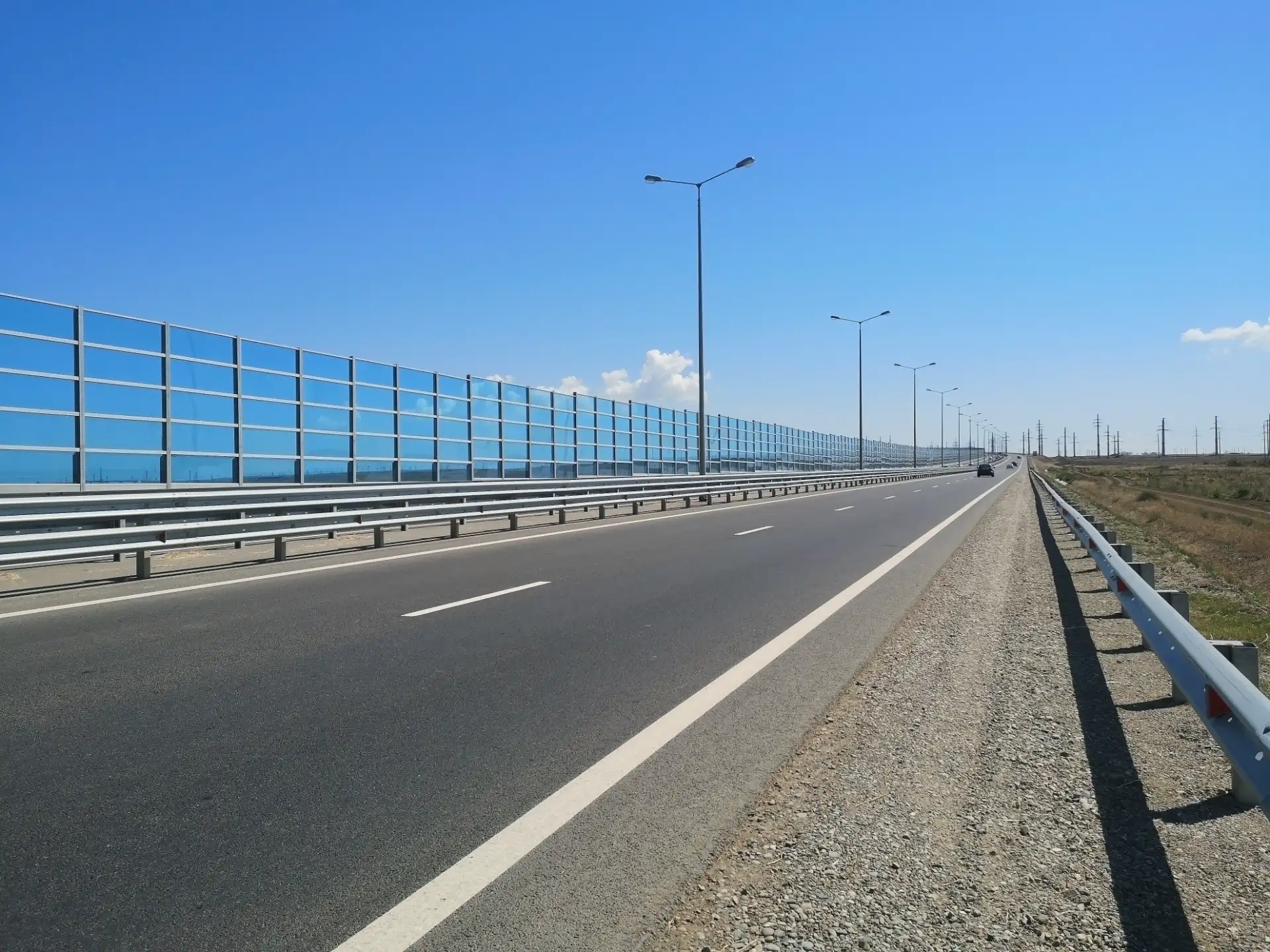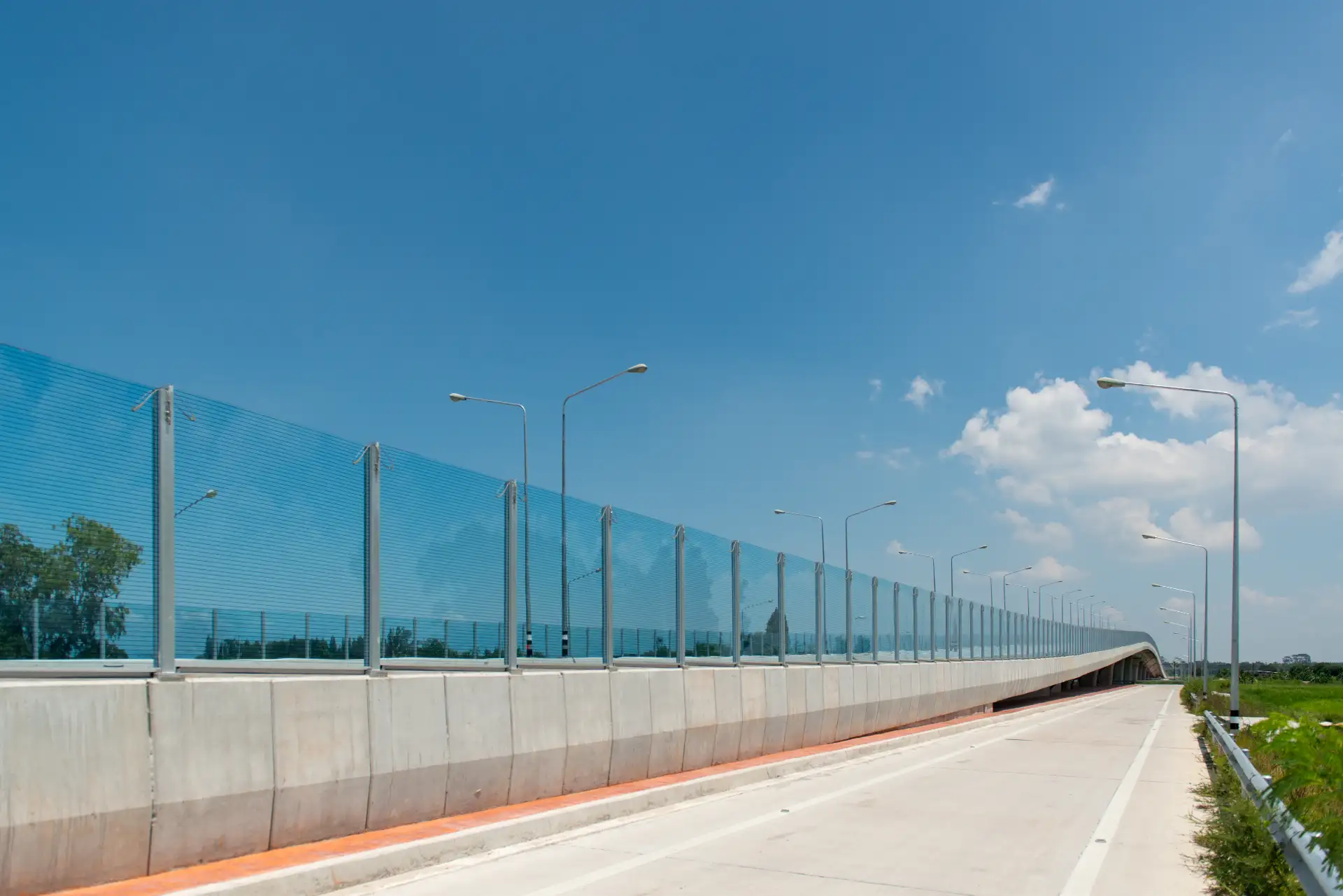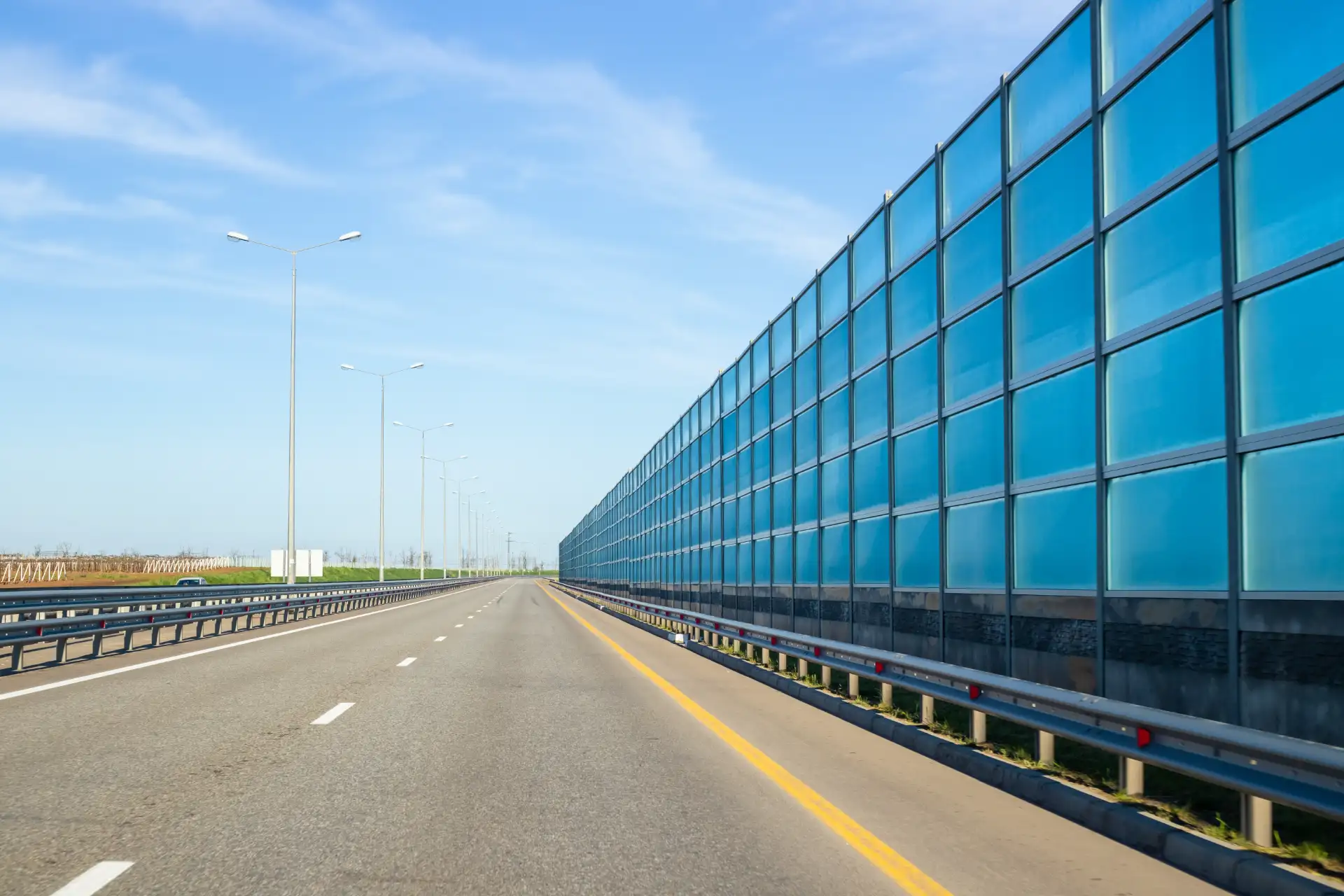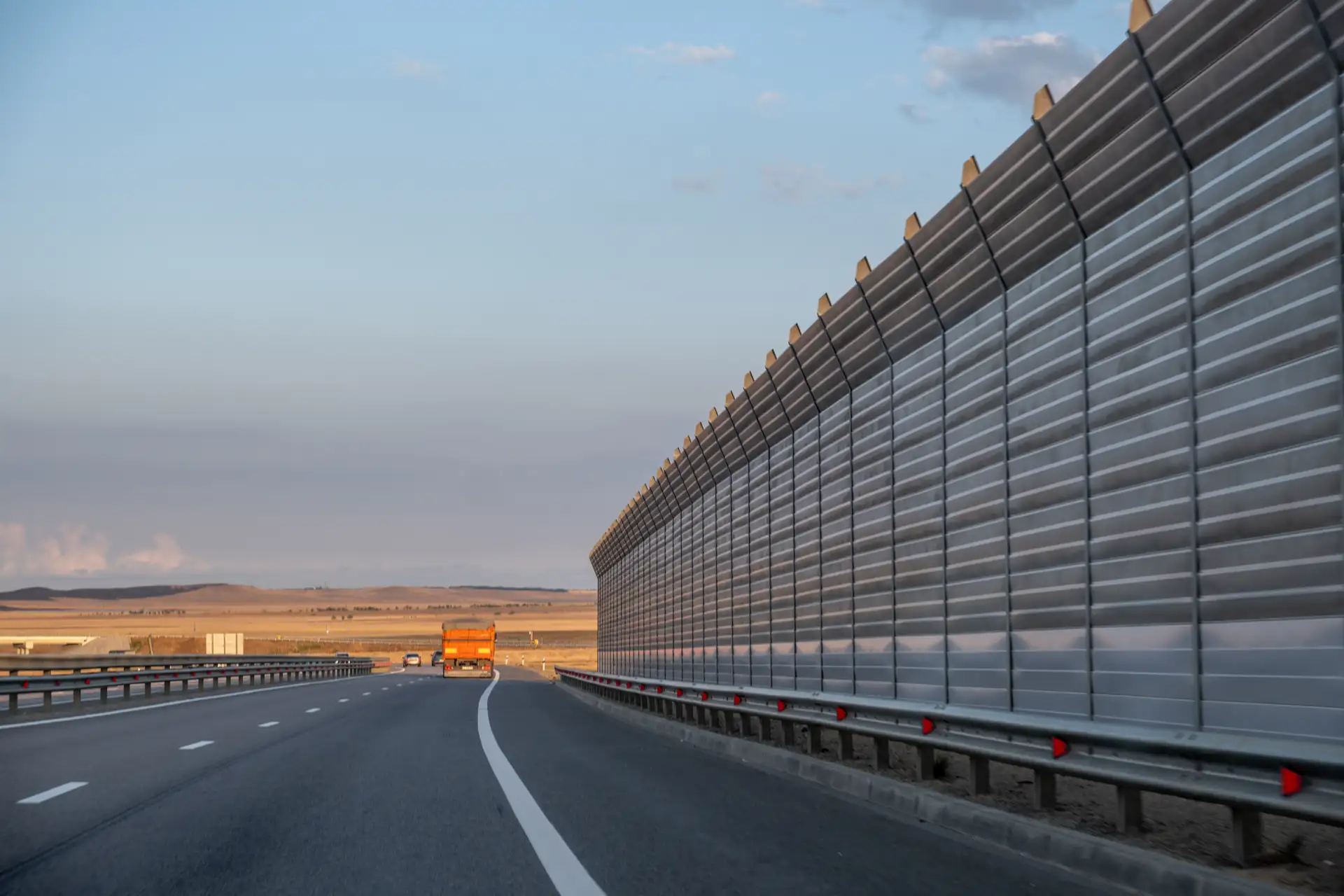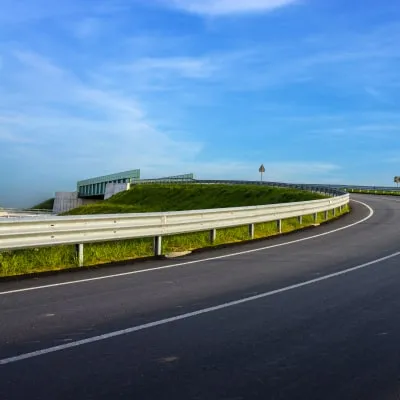 Highway Acoustic Noise/Sound Barrier Wall
Highway Acoustic Noise/Sound Barrier Wall
Types of Noise Barrier
Reflective Noise Barriers
A Reflective Noise Barrier is a sound control structure designed to deflect and redirect noise away from residential or sensitive areas instead of absorbing it. Made from durable materials like solid or multiwall polycarbonate sheets, these barriers are highly effective along highways, bridges, and urban roads where maintaining visibility and aesthetics is important. Their smooth, transparent surface reflects sound waves back toward the traffic source while allowing natural light and clear visibility, making them a practical and visually appealing solution for modern infrastructure projects.
Features of Reflective Noise Barriers
Panel Thickness: Available in a different range from 8mm to 20mm, allowing flexibility based on noise levels and project requirements.
Sound Transmission Class: Measures how well the barrier is effective in sound control with ratings between 18 dB to 26 dB.
Airborne Sound Insulation: Indicates how much sound is absorbed rather than reflected; range from 18dB to 30 dB, ensuring quieter surroundings for the nearby area.
Absorptive Barrier
Absorptive Noise Barriers are specially constructed using rockwool or glasswool insulation layered between metal sheets. These materials effectively absorb and dampen sound waves, preventing them from reflecting back into the environment. The application of this product is based on the material composition or specific project requirements, ensuring customised acoustic performance for each installation.
Features of Absorptive Noise Barrier
Panel Thickness: range from 100mm to 150mm, providing strong sound absorption and structural stability based on project needs.
Sound Transmission Class: Ability to block sound; ranges between 20 dB and 45 dB, ensuring a significant reduction in noise transmission.
Airborne Sound Insulation: It measures how efficiently the barrier absorbs airborne noise; it ranges from 18dB to 45dB, creating a comfortable environment near highways and urban zones.
 Product Specification
Product Specification
- Panel Sizes: 5000 x 500 mm, 4000 x 500 mm, 3000 x 500 mm, 2000 x 500 mm
- Panel Thickness: 80 mm | 100 mm | 120 mm
- Wind Load: Designed as per IS 875 Part-III, 1987
- Sound Proofing: Class A4
- Type of Wall: Double skin insulated wall
- Facing Sheet: Plain metal sheet / GI sheet / aluminium, 0.5 to 1.2 mm thick
- Backside Sheet: Perforated sheet / GI sheet / aluminium with 35–50% open area
- Infill/Core: Rockwool conforming to IS-8183 & BS 476, varying density and thickness, covered with fire-resistant fiber tissue paper
- Cover: Water-repellent tissue paper for infill material lamination, 50-micron thickness
- Joint: Each panel with tongue & groove design for perfect alignment
- Gasket: Neoprene rubber gaskets at joints to prevent noise leakage
- Vertical Post: ‘H’ profile or ISMC section post in which acoustic panels slide longitudinally
- Finish: All metallic surfaces/parts are galvanized, powder coated, or painted in desired shade
- Height: 1.5 meters to 2 meters
- Polycarbonate sheet Thickness: 8 mm | 10 mm | 12 mm | 16 mm
- Wind Load: Designed as per IS 875 Part-III, 1987
- Sound Proofing: Class A4
- Facing Sheet: Polycarbonate Sheet (Solid/Multiwall)
- Cover: UV coated
- Gasket: Neoprene rubber gaskets at joints to prevent noise leakage
- Vertical Post: ‘H’ profile or hollow rectangular pipe section post in which acoustic panels slide longitudinally
- Finish: All metallic surfaces/parts are galvanized, powder coated, or painted in desired shade
- Lightweight Design: Easier installation and reduced structural load compared to traditional glass barriers.
- High Visibility: Maintains clear transparency, ensuring open views and preserving the natural surroundings.
- Long-Lasting Durability: Highly resistant to impact, breakage, and vandalism for dependable outdoor performance.
- Weatherproof Performance: Excellent resistance to UV rays, rain, and extreme temperatures, ensuring long-term clarity and strength.
- Flexible Design Options: Can be curved, bent, or shaped easily to match various architectural and engineering needs.
- Certified Quality: Complies with international standards for safety, quality, and acoustic performance.
- Fire-Resistant: Constructed with fire-rated materials to enhance safety along highways and urban structures.
- Enhanced Acoustic Control: Effectively reduces traffic noise to create quieter, more comfortable environments.
- Eco-Friendly Construction: Made from recyclable and sustainable materials to support green infrastructure.
- Superior Noise Reduction: Effectively absorbs and minimizes reflected sound, ensuring a quieter environment on both sides of the barrier.
- Enhanced Acoustic Performance: Designed to deliver high sound absorption, especially ideal for areas with heavy traffic or industrial operations.
- Durable Construction: Made with robust materials like rockwool or glasswool sandwiched between metal sheets for long-lasting performance.
- Weather and Fire Resistance: Withstands extreme weather conditions and offers fire-resistant properties for added safety.
- Customizable Design: Can be tailored in size, color, and finish to match project aesthetics and technical requirements.
- Low Maintenance: Requires minimal upkeep due to corrosion-resistant and dust-repellent materials.
- Eco-Friendly: Built using sustainable materials that reduce environmental impact while ensuring effective sound control.
Typical Sound Level Calculations
| Sound or noise example | Sound level | Comment |
|---|---|---|
| Human ear | 0 dB | This is a matter of definition |
| Rustle of leaf | 20 dB | |
| Whisper | 30 dB | |
| Normal conversation | 60 dB | |
| Inside passenger car at 60 MPH | 65 – 75 dB | Smaller cars are usually noisier |
| Ringing telephone | 80 dB | Measured close to the phone |
| Hair dryer | 85 – 90 dB | Measured close to the dryer |
| Lawn mower | 85 – 90 dB | Measured at the ear |
| Maximum exposure, 8 hours | 90 dB | OSHA regulation |
| Chain saw | 90 – 100 dB | Measured at ear, sound level varies by model |
| Tractor/Bulldozer | 95 – 105 dB | Inside cab may be less noisy (sound level varies by model) |
| Rock drill | 110 – 115 dB | |
| Circular saw, table saw | 110 dB | |
| Threshold of pain | 120 dB | A matter of definition |
| Pneumatic chipper | 120 dB | |
| Fire engine siren | 120 dB | |
| ET engine at takeoff | 140 dB | |
| 12-gauge shotgun | 165 dB | Impact sound uses a different risk criteria |
| Rocket launch | 180 dB | |
| Loudest possible sound | 195 dB |
 Application Areas
Application Areas
Our advanced noise barriers are designed for a wide range of applications, ensuring effective noise reduction and enhanced safety in both urban and highway environments. With proven performance and durability, our barriers help protect communities from traffic noise while maintaining visibility and aesthetics, reinforcing our position as a leading noise barrier manufacturer in India. These sound barriers walls are implemented across numerous high-profile projects, including national highways, expressways, bridges, and urban development corridors, providing a quieter and more comfortable environment for residents and commuters alike.
 Related Products
Related Products
related products
 FAQs
FAQs
Highway noise barriers, also known as sound barrier walls, acoustic barriers, or noise walls, are exterior structures designed to shield nearby residential or commercial areas from excessive traffic noise.
Yes, transparent highway noise barriers made from polycarbonate or acrylic materials are effective and aesthetically appealing. They maintain visibility and natural light while reducing traffic noise levels efficiently.
Common materials used in highway acoustic barriers include metal sheets, aluminium, polycarbonate panels, concrete, and rockwool insulation. These materials are selected based on sound absorption capacity, durability, and project requirements.
The height of a highway noise barrier wall generally ranges between 3 to 6 meters, depending on the road design, traffic intensity, and the required level of sound reduction for the surrounding area.
The primary function of a highway noise barrier is to reduce the transmission of traffic noise from busy roads into nearby residential, commercial, or sensitive zones such as schools and hospitals.
Noise barrier walls are typically installed along highways, expressways, flyovers, railways, and industrial zones to protect nearby communities from continuous noise exposure.
Reflective noise barriers redirect sound waves away from populated areas, while absorptive noise barriers absorb sound energy to minimize reflection. Both types are used depending on the project’s acoustic and environmental needs.
The design of sound barrier walls involves factors like material density, barrier height, panel thickness, and placement angle. These parameters ensure maximum noise reduction and durability in varying environmental conditions.
Utkarsh India offers high-quality highway acoustic barriers engineered for long-term performance, weather resistance, and aesthetic appeal. Our customized designs ensure effective noise control for highways, bridges, and urban infrastructures across India.


